|
Wasana
Srisang
is
an
independent
artist
with
an
articulate
and
worldy,
impression
of
her
work.
JY.
Tell us what you would like to share with readers around the world about acceptance of the work you create and what experiences you would like to share with new artists
WS.
My art does not adhere to a style that must always have the same type of format. The stories that are conveyed differ depending on the situation. Places change, thoughts change.
During
the
time
of
change,
the
work
landscape
also
changes.
If
the
mind
is
not
ready
to
do
it,
then
it
will
not
be
done.
There
are
no
sketches,
but
it
is
a
solution
to
the
problem
in
the
actual
piece
on
the
frame.
Personally,
I
graduated
with
a
major
in
Thai
Painting.
Of
course,
my
early
paintings
were
in
the
ancient
Thai
tradition
adhering
to
cultural
traditions
which
the
new
generation
may
consider
old-fashioned
or
outdated,
but
it
is
my
pride
to
learn
the
roots
of
the
culture,
life
and
spirit
of
Thai
artisans
in
the
past.
Using
traditional
colors,
powder
that
comes
from
nature
is
fermented
to
be
used
for
painting
or
even
grinding
rocks
to
turn
them
into
paint.
This
is
detailed
work,
takes
time,
and
has
a
complicated
process.
With
these
various
backgrounds,
I
have
been
shaped
into
a
person
who
works
in
detail
and
meticulously.
Later,
my
style
of
work
began
to
change
to
powder
or
natural
colors
not
being
able
to
meet
the
needs
of
my
work.
Acrylic
paint
was
a
new
option
that
has
played
a
part
in
developing
my
work.
My
art
began
to
break
away
from
the
traditional
style,
gilded
with
gold,
cut
lines
like
traditional
Thai
art.
Started
to
turn
to
the
stories
surrounding
our
way
of
life.
At
that
time
I
had
the
opportunity
to
study
in
India.
Impressions
of
folk
life.
People
in
a
village
made
of
clay.
A
simple
but
peaceful
existence.
Indian
colors
began
to
play
a
role
in
my
paintings.
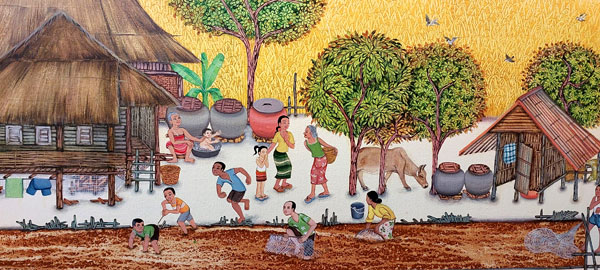
An Indian teacher advised me to learn ancient Indian painting.
Illustrations of Indian mythology. A brilliance in the use of color. During
this time in India, my painting styles were of two types: Indian village- life
style and portrait.
When I returned to live in Thailand, my thoughts changed back to wanting
to draw the life of rural Thai communities. During that time I had the
opportunity to help with temple work at Doi Tao. Therefore I had the
opportunity to experience the atmosphere of life of rural people. Rice
fields on the edge of the horizon that are verdant. And sometimes golden
yellow as the seasons come and go. It's like my life and work will change
without any attachment and may return to the traditional style. Which is
true……returning to the various gods.
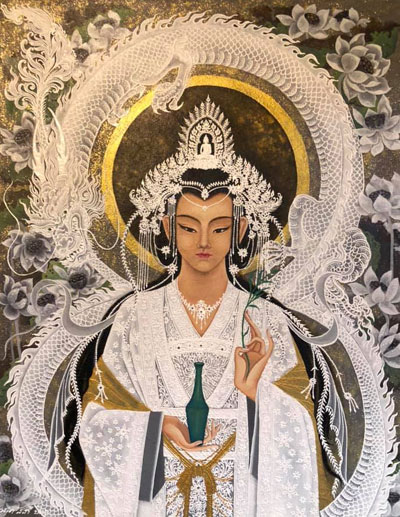
With Thai people's belief in the gods Brahma, Shiva, Mae Uma, Lakshmi,
Ganesha, Lord In, the Naga, Rahu, Thao Vessuwan, Guanyin, they are all
deities that Thai people respect. Saimu science has begun to play a role in
modern society. So I turned to drawing the gods using a combination of
unique drawing techniques, which may have come from cultivating Thai
painting mixed with Indian painting.
And when it got to the point of boredom creeping in again, I found a new
way, a new story until it resulted in a new work with the main character
being a rabbit.
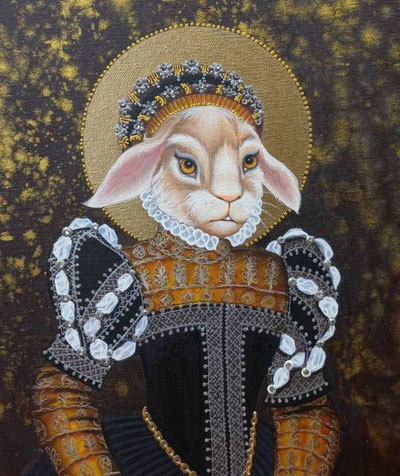
In my modern works, I use rabbits as a creative medium. Why is it a rabbit?
Rabbits are little animals that have been with humans for a long time. In
many cultures Rabbits are considered symbols of good luck: abundance,
wealth and a symbol of love in the family. Rabbits are therefore legendary
animals. Various imagings become stories, Fairy tales with morals related
to rabbits in each country.
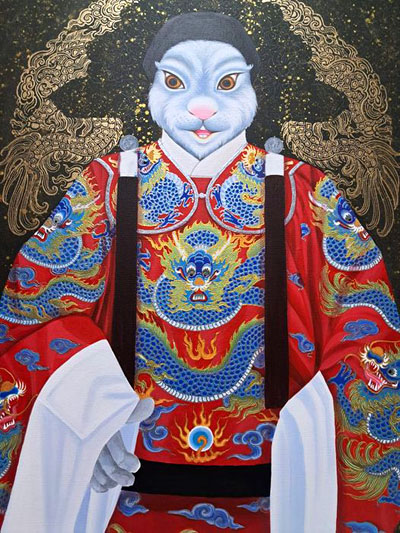
Thus, the Rabbit Theater in my imagination was born. Bringing together
clothing that is unique to different nationalities. Impressed by the colors
and beauty of the clothes. Headgear which is the evolution and culture of
each race that shows that the country has had a great civilization and
prosperity for a long time.
JY.
Tell about your past history, life, studies both in Thailand and abroad.
WS
. It is a life of studying art since vocational certificate studies at Samut
Prakan Technical College (Bang Pu), the subject of study is Arts and Crafts.
That is, I studied all types of handmade art, such as drawing, sculpting,
casting, weaving, love work, Benjarong, pottery, leather goods, Thai
painting. This institute sparked my desire to study Thai painting later on.
Vocational Certificate, Rajamangala Institute of Technology (Poh Chang),
Major in Thai Painting. In the past, it was a difficult field to enter. There
were many applicants. Along the way, you may not be able to complete
your studies because of the stubbornness of the teacher who wishes the
best for his students.
Bachelor's degree from Rajamangala Institute of Technology (Khlong Hok)
was a study pattern that continues from Poh Chang to Rajamangala
University of Technology (Khlong Hok). Study for two years and receive a
degree. During that time, I majored in Thai painting in the teacher field
(studying to be an art teacher) because I didn't have a direct line (studying
to be an artist).
After finishing my bachelor's degree, I began drawing pictures and
submitting them to competitions in various stages. I received this first
award, the Bronze Medal for Bang Luang Painting, and submitted to
competitions in various institutions and continually received awards until
deciding to continue studying
Advance diploma program at Visva-Bharati University Shantiniketan,
India. Sent the application via international post. Waited for a year not
knowing if I will be selected to study or not. Did the document get lost
along the way? There was no answer, so I set out to find the answer. The
reason why I chose this place as a learning center was because my
girlfriend invited me to follow in the footsteps of Ajahn Fue Haripitak and
thought that this place would expand on the mural work. I wanted to study
mural conservation work. All I know is that it is an immortal place that has
cultivated many artists.
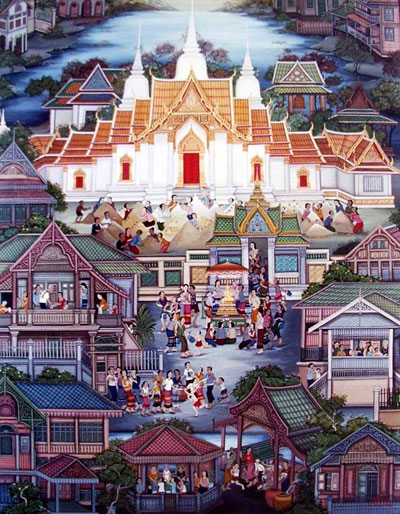
But the result is that there was no teaching about conservation work. And
as a result of the admissions selection, I was chosen and was therefore
confused...confused. The course I studied was an Advance Diploma or
Master's degree diploma. Just study, practice, no need to study theory.
Practical subjects are studied together with master's degree students. The
selection of people to study there makes me very proud. In one room there
were Indian students who came from each state uniquely, as was the
principle intention of the institute's founders. To be the center point
between the West and the East, without borders. There were 12 Indian
friends in the class. One foreigner would be chosen to study in each class.
That is, I was the only foreigner in the class. It took me two years to study.
Teaching there doesn't have a teacher who comes along to teach you.You
have to take responsibility for yourself and do the work. It's a time for the
teacher to give guidance on what areas we should study further without
taking the teacher's opinions into our work. Freedom of thought . In one
semester, check work twice. You have to do your best work and on exam
day your performance will be the indicator. All students in the faculty and
the general public can view the work you have done throughout the
semester.
After graduating, I continued to live and study for another year in India.
Had the opportunity to go to the southern tip of India. I wanted to study
mural painting in Kerala, which I studied in a concise manner and did not
take long because I have a background in Thai painting which is popular at
the Guruwayu Institute. Overall drawing and coloring hits the same line.
Similar natural color sources. The difference is that the glue, the bonding
agent and the method of making the wall are very different.
Overall, life in education in India is rich because it is not only in the
classroom. But it is the life that I have to live in society, my village, my
neighbors, including how to travel safely. Happy and comfortable, India is
a good answer to life. Poor or rich are on the same train car. There are cars,
motorcycles, bicycles, cows, goats, dogs, cats, and donkeys on the same
road. It is a city that teaches you how to live your best life.
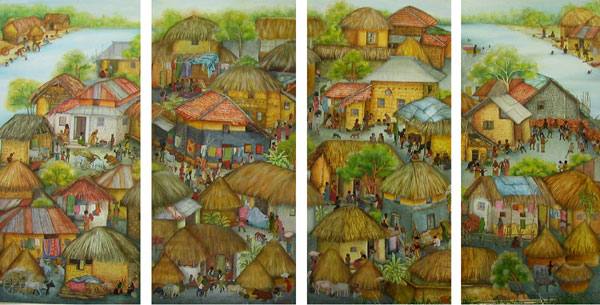
JY.
Which artist's work do you like the most? Can be a Thai or foreign
artist.
WS.
The artist I especially admire is Gustav Klimt. Thai artists like the
work of Master Chalerm Nakiraks.
JY.
To what extent are you satisfied with your past work?
WS.
I am satisfied with my past work that every piece was successful. I
liked it during that time. But looking back, there may be things that need to
be corrected. It will be developed in the next piece.
JY.
What about your materials and techniques the artists you have worked
with?
WS.
Painting equipment and techniques are individual matters. Must
simply try and practice. Do it yourself and you will know. Choose good
quality things first. Don't be selfish with cheap things. Expensive things can
shorten the work time a lot, such as high series colors. Mix colors however
you want. But low series colors, no matter how you mix it, it doesn't work
as you want. I accidentally mixed it until I had to throw it away.
I once participated in a painting project with my boyfriend (Kritsana
Chuankunakorn) and participated in creating a painting in the church of
Anantamethayaram Temple, Singapore. It took three years to draw with
just two people. But I had the opportunity to see some of the big art
exhibitions that Singapore held during my time there. In most art
exhibitions, I always performed alongside Kritsana.
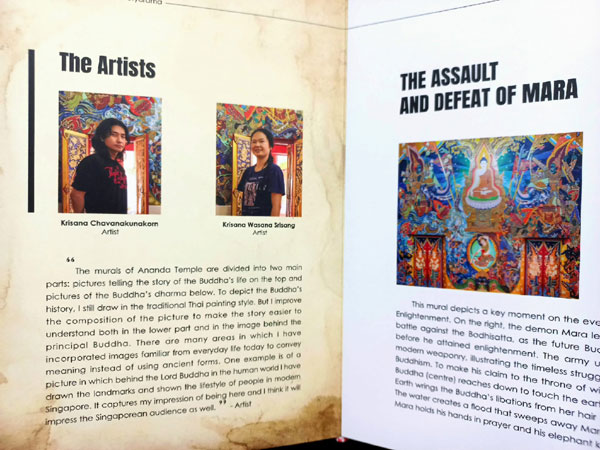
Thai artists' contribution to society today is considered even better. The
new generation clearly has access to art. Popular street art, people who
have not learned about art can absorb it and understand it. Just seeing the
colors makes them amazed. The more tangible works of art, people who
watch as part of the event create more happiness and fun with the
audience. It's not a one-way communication, but there are people who
receive the message and have access to the message that the creator wants
to present. Art is no longer a matter that is so high that it is out of reach.
|